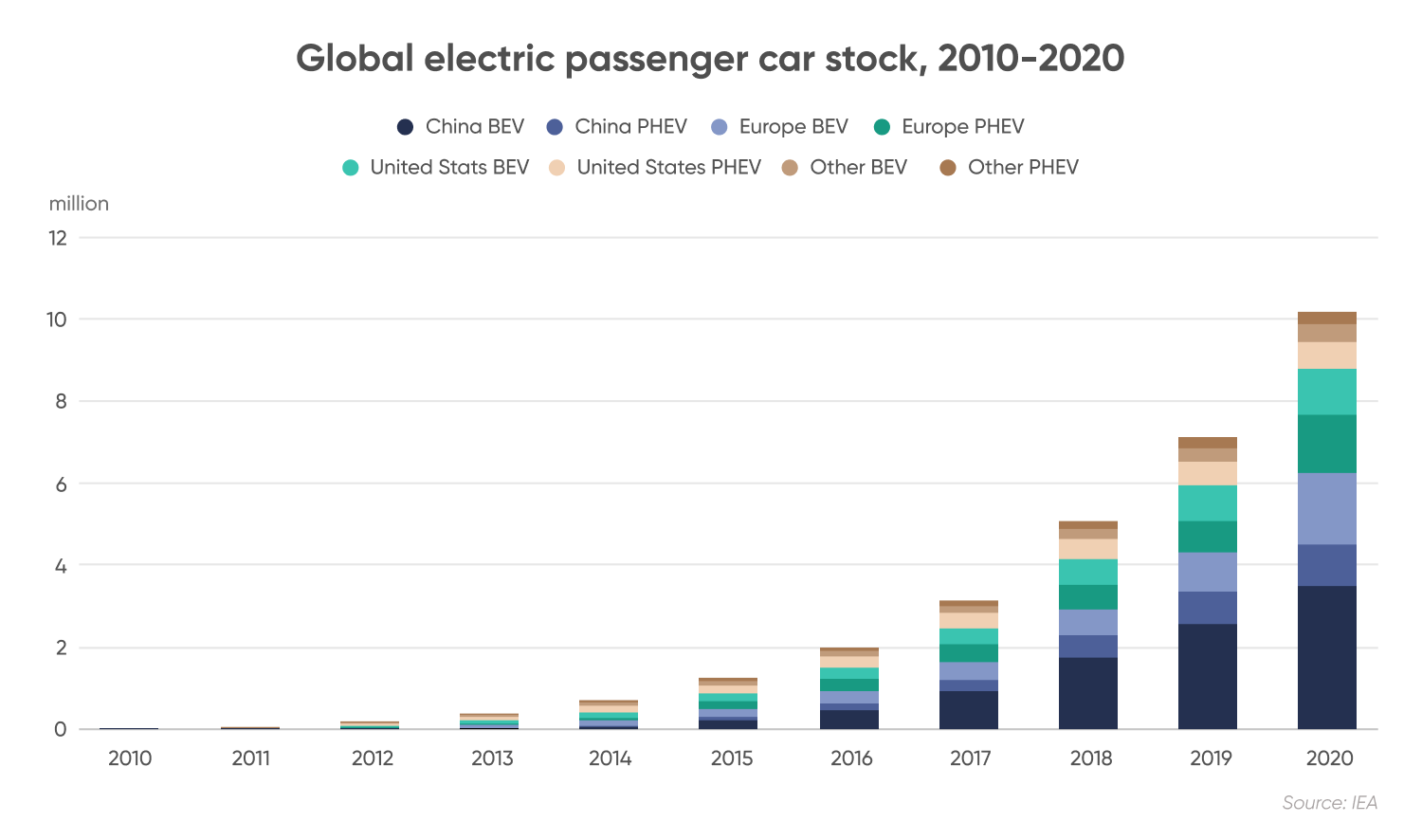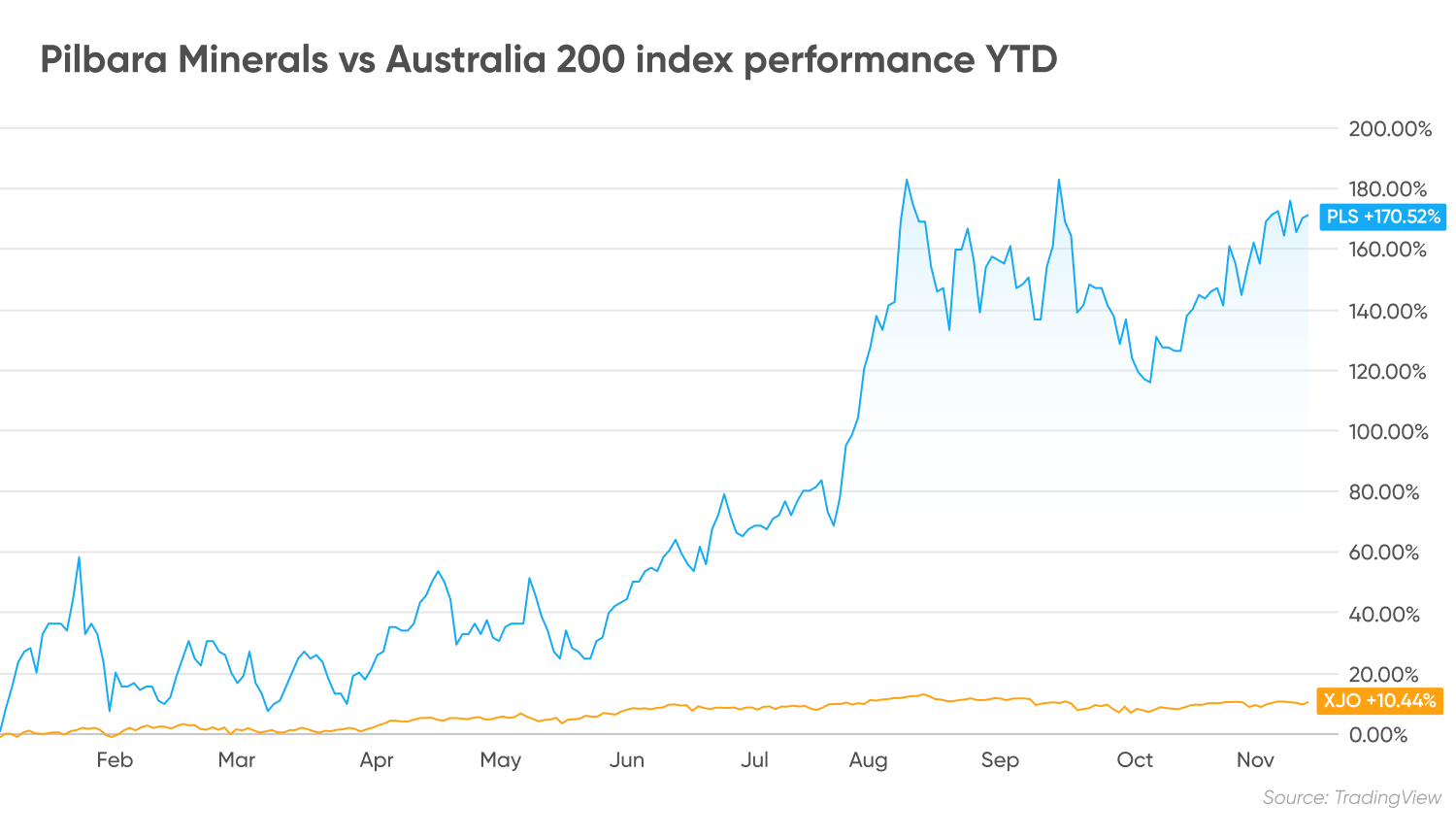Pilbara Minerals share price forecast: Green energy push to keep PLS rising?
Does the Pilbara Minerals (PLS) stock have enough room to grow further? Read more...
Like many in the lithium mining business, the boom in electric vehicles has helped Pilbara Minerals see its share price recover from the doldrums. The Australian company’s stock has risen nearly 170% so far this year, trading at above AUD2.30 ($1.68) per share.
Industry analysts have forecast lithium prices will continue to rise in line with growing demand for EV as countries race to meet their decarbonisation targets.
The article will discuss Pilbara Minerals’ stock forecast and PLS price analysis in 2021 and beyond.

Pilbara Minerals outlook
Pilbara Minerals is the leading pure-play lithium miner at the Australian Stock Exchange (ASX). The Perth-based company produces spodumene and tantalite concentrates from its flagship Pilgangoora Project, the world’s largest independent hard-rock lithium operation, which is situated in Western Australia’s Pilbara region.
Western Australia itself is the world’s largest mined lithium producer, accounting for 21% of the world’s lithium reserves in 2020, according to data from the West Australian Government.
Spodumene concentrate is a key element in producing the lithium chemical that goes into electric vehicle batteries. The mineral is Pilbara Mineral’s main product.
The company is “pursuing a growth and diversification strategy to become a sustainable, low-cost lithium producer and fully integrated lithium raw materials and chemicals supplier in the years to come”, according to its website.
The Pilgangoora operation has two processing plants: the Pilgan Plant on the northern side of the Pilgangoora area and the Ngungaju Plant, which was acquired through a lithium project owned by its peer, Altura Mining.
The Pilgan Plant produces roughly 330,000 tonnes per year of 6% spodumene concentrate and 321,000lbs per year of +5% tantalite concentrate.
For the Ngungaju Plant, a final investment decision has been made for a staged restart by the end of 2021 with a production capacity target of 180,000 to 200,000 tonnes per year by mid-2022, according to the company’s presentation.
Pilbara Minerals share price analysis: how has the share performed
For much of 2020, Pilbara Minerals’ stock had hovered between AUD 0.19 and AUD 0.40 per share, but the company’s share price started to climb in October 2020 as countries raced to announce commitments for net-zero emissions as car makers ramped up electric vehicle output.
According to the International Energy Agency (IEA), and despite the Covid-19 pandemic, global electric car stocks hit the 10 million mark in 2020, a 43% increase over 2019. Battery electric vehicles (BEVs) accounted for two-thirds of new electric car registrations and two-thirds of the stock in 2020.

As of 11 November’s close, Pilbara Minerals’ shares were trading at AUD2.34 apiece, 7.5% lower than its record high price of AUD2.53 per share on 15 September. The share has surged by 170.52% so far this year. In the same period, the Australian Securities Exchange (ASX) 200 Index rose by 10.44%.

Pilbara Minerals latest news: what spurred share price to rally
Several key events have kept the Pilbara Minerals share price heading north since the start of the year, despite it booking a net loss of AUD51.4m for the 2021 financial year, ending in June.
In January this year, the company completed the acquisition of all of the shares in Altura Lithium Operations, which owned the Altura Lithium Project for an upfront cash payment of AUD201m.
“The deal is a good fit for Pilbara Minerals because Altura’s Pilgangoora mine is adjacently located, making the acquisition easy to integrate and generate economies of scale,” wrote Henry Fung, co-founder of MF & Co. Asset Management, on 2 September. MF & Co. Asset Management is a boutique investment firm, offering investment management and advice for US and Australian market execution.
Pilbara has successfully fetched high prices for its spodumene through auctions at its online trading platform Battery Metal Exchange (BMX). Since its maiden online auction on 29 July, BMX has held three auctions.
In its third auction on 26 October, Pilbara Minerals sold 10,000 dry metric tonnes (dmt) of spodumene at a record price of $2,350/dmt (SC5.5, FOB Port Hedland basis). The third auction price was also nearly double the $1,250/dmt achieved at the first auction.
On the mining side, on 6 September, Pilbara Minerals announced its lithium resource had increased by 39% to 308.9 million tonnes, compared with the depleted resource statement as of 30 June 2020.
The increase was the result of its 2021 exploration and development drilling campaign adjacent to the historical Altura tenement boundary, along with the integration of resources from the recently acquired Altura Lithium Operation, the company revealed in its statement.
On 26 October, Pilbara Minerals announced it had agreed to form a joint venture with South Korea’s POSCO, one of the world’s top steel producers, to jointly construct and operate a lithium hydroxide monohydrate (LHM) conversion facility in South Korea. The facility will have the capacity to produce 43ktpa battery-grade LHM.
Lithium price outlook
The Australian Government’s Office of Chief Economist (OCE) has forecast lithium prices to rise over the coming years, after dropping in 2020 due to an oversupply combined with slower growth in electric vehicle demand in China, partly due to the Covid-19 pandemic, the West Australian Government said in its West Australian Battery Minerals Profile - September 2021.
The price of Spodumene is forecast to rise to $899 a tonne in 2021 and $1,191/tonne in 2022 from $437 in 2020, according to the OCE. Lithium hydroxide’s price is forecast to rise from $9,892 a tonne in 2020 to $13,122 a tonne in 2021 and $15,083 a tonne in 2022.
The OCE also forecasts that global lithium demand will increase more than three-fold to 1,038 million tonnes in 2026, from 305,000 tonnes.
Fitch Solutions in its May forecast lithium prices to remain elevated in the short-term:
“We expect broad lithium prices to trend higher in 2021 and 2022, as accelerating demand for Li-ion batteries and a tight upstream supply keeps prices elevated,” Fitch said in a note on 21 May.
It forecast the price of China lithium carbonate to rise to $15,025/tonne in 2022 and to $15,595/tonne in 2025 from $13,450/tonne in 2021. The price of China LMH is forecast to rise to $14,300/tonne in 2022 and $17,500/tonne in 2025 from $11,950/tonne in 2021.
In a separate note on 2 July, Fitch expects lithium consumption growth to outpace current supply developments supported by strong government support in major economies to promote EVs on a large scale.
Pilbara Minerals’ annual and quarterly updates
In its first quarter 2022 report, Pilbara Minerals reported a record production of 85,759dmt of spodumene concentrate, a 11% rise from the fourth quarter of FY 2021 ending June.
For the three months to September 2021, the company shipped 91,549 dmt of Spodumene concentrate shipments, exceeding guidance of 77,000-90,000 dmt.
“The quarter saw continued strong improvement in lithium market conditions,” the company said in the statement, adding that it expects these conditions will continue.
It forecast spodumene concentrate production for the December quarter of 2021 to be in the range of 90,000 to 115,000 dmt, inclusive of both Pilgan and Ngungaju plant production.
The company’s actual average pricing received for September spodumene concentrate deliveries was in the range of USD$850-$900/dmt.
For the Financial Year 2022, Pilbara Minerals expects to produce between 460,000-510,000 dmt of spodumene concentrate, up from 281,098dmt in 2021. It expects to ship 440,000-490,000dmt in FY 2022, up from 281,440dmt in the previous financial year.
It expects unit cash operating cost of AUD525-AUD575/dmt in FY2022, up from AUD519/dmt.
“We’re going to be one of the lowest cost mines in the hard-rock suite globally. That’s driven by our location, being so close to the port-to-port Hedland. But of course also because of the economies of scale, it’s becoming a very, very big mine,” said Ken Brinsden, Pilbara Minerals’ Managing Director and Chief Executive Officer, in a speech on 20 October.
Pilbara Minerals share price forecast: price targets for 2021, 2022 to 2025
On 28 October, Macquarie Research maintained its 12-months price target for Pilbara Minerals at AUD2.80 apiece or 19.6% increase from the current price as it expects a higher realised spodumene price.
Macquarie Research lifted Pilbara Minerals’ realised spodumene pricing forecast to $1,650/dmt (CFR) for the second quarter in FY 2022. But it maintained its forecast for the third quarter at $1,200/tonne along with $1,600/tonne in the fourth quarter.
“PLS’s near-term cash flow outlook is strong with volumes and realised prices expected to rise materially in the 2QFY22,” Macquarie Research said in its note.
It maintains Outperform rating for Pilbara Minerals as the company’s realised price guidance in the range of $1,650 to $1,800/dmt (CIF China) presents a material upside to its forecast for the second half of FY 2022.
Is Pilbara Minerals ‘buy’, ‘sell’ or ‘hold’? Among seven analysts tracked by WSJ Markets, three have a buy call on the stock. Two recommended hold, one has an underweight call, and one sell. The median target price by those analysts is at AUD2.29, with the lowest PLS share price forecast at AUD2.00 and the highest at AUD2.80.
WalletInvestor’s Pilbara Minerals share price prediction suggests the PLS stock price will rise to AUD2.94 per share in 2022. For 2023 until 2025, WalletInvestor estimated stock price to rise to AUD3.502 (2023-end), AUD4.05 (2024-end), and AUD4.6 (2025-end).
David Franklyn, Executive Director & Head of Funds Management of Australian investment house, Argonaut, rated Pilbara Minerals as a buy.
“Basically, it’s in the right place at the right time. It’s a large-scale producer at a time when the lithium price is continuing to escalate,” Franklyn said in LiveWire: Buy Hold Sell on 29 October.
Tim Serjeant, Portfolio manager at Eley Griffiths Group also rated Pilbara as a buy.
“It’s relatively better value than most of the lithium names at present. It’s got volume growth where others don’t at the moment in a record pricing environment, and it’s inherently scalable as the market continues to grow,” he said in the same show.
When looking for Pilbara Minerals stock forecasts, it’s important to bear in mind that analysts’ predictions can be wrong. Analysts’ projections are based on making a fundamental and technical study of the stock’s performance. Past performance is no guarantee of future results.
It is important to do your own research and always remember your decision to trade depends on your attitude to risk, your expertise in the market, the spread of your investment portfolio and how comfortable you feel about losing money. You should never invest money that you cannot afford to lose.
FAQ
Is Pilbara Minerals a good investment?
Most analysts mentioned above believe that lithium miners such as Pilbara Minerals might present a buying opportunity with a forecast of high lithium price in coming years due to strong demand for electrification in transportation.
Keep in mind that analyst predictions can go wrong and conduct your own due diligence before making any trading decision.
Will Pilbara stock go up?
Macquarie Research in its 28 October note maintained its 12-months price target at AUD2.80, up nearly 20% from its current price as the higher realised price of spodumene might result in a near-term strong cashflow outlook.
Does Pilbara Minerals pay dividends?
There is no dividend history for Pilbara Minerals.